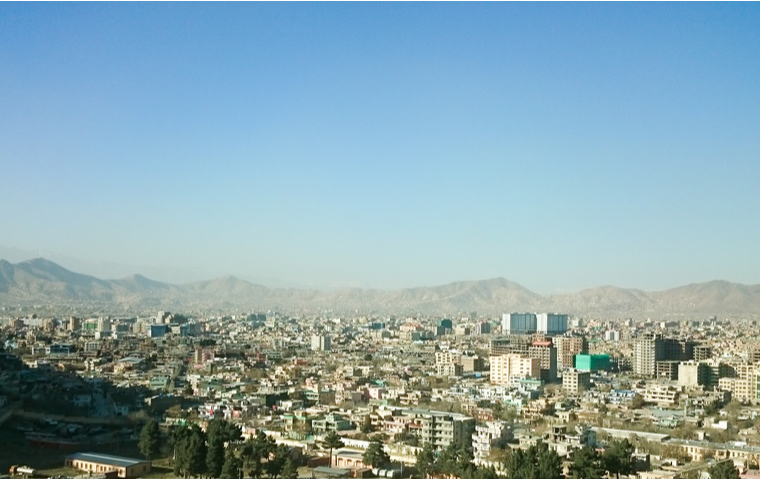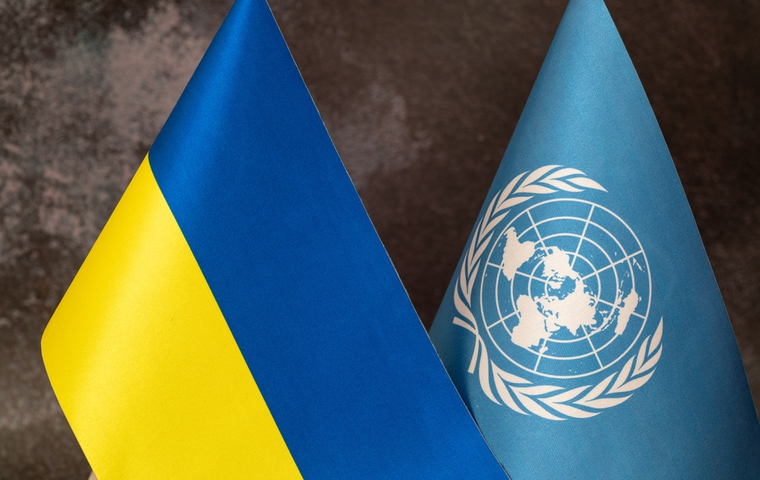How Military-First Knocked Afghanistan into a Downward Spiral, Unable to Stand on Its Feet
Related Articles

A tense atmosphere always accompanied my ride to the Kabul International Airport. In 2011, I was Japan’s Ambassador to Afghanistan, and wherever I went, four fully armed guards escorted me. Each time I headed to the airport for my regular trips to Japan, the head of the security team, with experience fighting as a special forces soldier in a major European country, would warn me:
“The most important thing in avoiding terrors is not letting the terrorists predict your schedule. If they don’t know your destination or the route, they can’t plan an attack. So the airport is the worst case. When you travel to Japan, you have to go through there. The roads to the airport are limited and you have no choice. Since an unspecified number of people gather at the airport, you can’t check everybody. You have to be fully aware of your disadvantages, and act cautiously.”
A decade later, many lives are lost in the suicide bombing in front of the airport in Kabul, now completely under the Taliban’s control. As I watch this on TV, I recall the faces of various people I worked with in Kabul, along with a bitter feeling—what was it that the international community tried to attain by sacrificing 20 years, a huge amount of taxpayer’s money, and above all, many precious lives?
Since the times of Alexander the Great, this country has ceaselessly faced invasion and control by external enemies, yet never allowed permanent rule by any conqueror, earning the name “the graveyard of empires.” Based on my exchanges with the various people I met in the year and a half from 2011, I would like to discuss what the U.S., NATO, and Japan tried to achieve with Afghanistan, what the strategy was, and why it failed.
The Recognition of the Western Diplomatic Corps
It all began in 2001, from the 9/11 terrorist attacks in the U.S. Various reasonings were discussed on how to justify the following U.S. military campaign. In sum, it was a revenge that had to be carried out, and Afghanistan became the target for the sole reason it was the den of iniquity that harbored terrorists. From this light, President Biden made a very honest confession at the press conference on the U.S. withdrawal from Afghanistan, by saying the nation building and democratization of the country were not what the U.S. aimed for.
In early 2011, when I arrived in Kabul as Japan’s ambassador, 10 years had passed since the Taliban was driven out from the capital, but almost 100,000 U.S. troops still remained and continued battles in various regions. President Obama had prioritized speeding up the U.S. military withdrawal and training of Afghan Forces and police for its replacement, and also requested the U.S. allies for maximum cooperation.
The International Security Assistance Force (ISAF), mainly consisting of U.S. Forces, confronted the Taliban across the country and had expelled them from the major cities in military terms. Yet, the Taliban can secure a de facto safe haven just by crossing the Pakistani border, and with each passing year, it became obvious it was impossible to eradicate or overthrow the Taliban by military force alone. I believe the shared recognition among the Western diplomatic corps in Kabul at the time was: have the Afghans themselves create an independent government, military, and police, then have them balance with and confront the Taliban across the country; the role of the U.S. and its allies is to provide support to speed up this process, and when security control is transferred to the Afghan Forces, the ISAF troops will naturally diminish.
Furthermore, if the government in Kabul can show achievement in maintaining security and reviving the local economy across Afghanistan, even though imperfect, it can secretly negotiate peace with the Taliban, and agree on power sharing that is acceptable for both the international community and the Afghan people. Such expectations, although not explicitly discussed, surely existed.
Dr. Tetsu Nakamura, who devoted his life to Afghanistan and died there, once said in a media interview, ”The Taliban is the farming community of Afghanistan itself.”
Taliban’s dogmatic interpretation of Islamic law and disregard for women’s human rights face strong opposition in urban areas. But in the history of Afghanistan, neither a government by a strong centralized state, nor democratic elections existed in the first place. In the divided land, many tribal societies had their own rules, and the Islamic teachings and these rules were entwined and weaved, like the warp and woof, creating a carpet with intricate patterns and no way to disentangle. Since the dawn of history, numerous foreign powers have attempted to invade and control this land, but realizing what existed behind the carpet’s surface, they could only stand in bewilderment, and retreat in vain, leaving corruption and chaos behind.
To avoid repeating this history, we should not deny the tribal political culture, but create a system to share power with the Taliban in some form. During my year and a half in Kabul, I heard this view in unofficial settings, from some Afghan politicians and multiple diplomats who have long been involved with Afghanistan.
Afghanistan is said to have enjoyed the most stable era during the monarchy in the 1970s. It was a governing system that respected the traditional authority by the elders and religious leaders, which differed by each region, while the central government in Kabul, with the king at the top, loosely reigned over. It is little known that during this time, the current Their Majesties the Emperor Emeritus and Empress Emerita visited Afghanistan as the Crown Prince and Princess and stayed for several weeks. Enabling such a visit shows how peaceful and stable Afghanistan was at the time. I had the opportunity to meet with former Princess Bilqis Begum in Kabul, who hosted the visit by the Japanese royal couple. I still remember the happy expression of the Princess when she recalled the peaceful times and shared her memory of touring around the country with the Japanese royals.
In 2011, as it became clear that a military solution was impossible, the Afghan issue’s key to the exit strategy was for (a) an independent government by the Afghans themselves to (b) establish a political solution (power sharing framework) tailored to the history and culture of Afghanistan, through negotiations with the Taliban.
Then, why did this political solution fail to realize in the following 10 years? To figure out the cause, we need to look at both the issue of the international community with the U.S. at the center, and the issue within the Afghan government.
The Logic of “Occupation Policy”
After driving the Taliban out from Kabul in 2001, the U.S. called for a coalition within the NATO framework and established the ISAF for maintaining public order and sweeping the Taliban. Japan Self-Defense Forces could not join this framework since it differed from the UN Peacekeeping Operations. So, Japan’s primary mission was to contribute to civilian stability through economic cooperation—collaborate with the U.S., UN, and various NGOs and prioritize aid projects and consult with the Afghan government as the counterpart to agree and implement the projects. This was the natural process for providing Official Development Assistance (ODA).
However, many involved in the aid in Kabul could not help feeling a huge frustration. As for each project, the Afghan government personnel worked on them earnestly, and the residents also showed a positive response. But when it gets closer to the government’s inner circle, such as the president, his aides, and cabinet members, the response clearly becomes slow. They nod during the exchange. But on the policy issues that are the prerequisite for providing aid, like the problems with the country’s long-term economy and budget, and the need for human development, they never gave sincere responses.
There was no problem accessing the government’s inner circle. Japan’s Ambassador could always meet upon request not only the cabinet members but also then-President Karzai, and his economic advisor Ashraf Ghani, who later became the president. They were generally pro-Japanese and highly appreciative of Japan’s assistance.
Despite this, there was always a sense of discomfort that could not be clearly explained. If we pointed out a problem, they would provide an answer. But it was obvious the answer was made up by some foreign consultant so that it would be “well received.” Even if the Afghan side had objections, if they spoke from their heart, we could respond. But in most cases, time just passed without candid discussions. As I continued my work in Kabul, though vaguely, I have come to realize the cause of the situation.
For the elites in Afghanistan, ceaselessly exposed to invasion by foreign forces in a divided land and society, politics begin with a quick and accurate grasp of where the power lies. This has nothing to do with principles or philosophy. All they do is instinctively figure out “who’s the strongest” by fact and reality and focus their whole attention there. It was apparent where the power in Kabul was at the time—the ISAF Commander, who is also the head of the U.S. Forces.

ISAF Commander David Petraeus was a veteran hero, who has been considered a future presidential candidate by the U.S. Republican Party; a star who also had political power. He later became the Director of the CIA but resigned after a personal scandal. He currently travels around the world as an executive of the major New York fund, KKR. After President Trump was elected, he was initially a prime candidate for the Secretary of State.
Before becoming the ISAF Commander, Petraeus was a highly respected Supreme Commander of the U.S. Forces in Iraq. In the so-called asymmetric warfare (guerilla warfare), instead of mere military power, he combined a strategy of winning hearts in the occupied region through quick-impact economic support, so that the achievements gained through operations can be expanded across regions. Dubbed counterinsurgency (COIN), the strategy contributed significantly to regaining public order in Iraq.
The COIN was also adopted in Afghanistan, and it was indeed showing results. Despite some suicide bombings and sporadic offensives, the Taliban during this time hardly made any visible expansion in occupied regions. There were also reports of a surfacing feud between moderates and hard-liners within the Taliban.
However, there was a big problem lurking here. Afghanistan had long been in a state of civil war since the Soviet invasion in the late 1970s destroyed the existing administrative organization. What was originally needed in this country was to discuss with the World Bank and the International Monetary Fund (IMF) to decide on a solid fiscal plan and macroeconomic policy direction. Based on this, through discussions with UN agencies and major donor countries, the Afghan government itself needed to take the initiative to decide the projects for the country to stand on its feet within five or 10 years.
Serious discussion would have made clear that what lacked was not only funds but also human resources throughout the administration and central-regional communications. It would also have shown the undisguisable corruption rooted at all levels of the government. At the aid meetings held almost every day in Kabul, whisperings on these issues took place in various forms. Yet, neither the Afghan government nor the partner countries could tackle this problem head on. Why was it so?
It is because maintaining public order and ensuring security was the overriding issue, and in Afghanistan at the time, this depended on the success of the ISAF military operations led by U.S. Forces. The logic of the military-first “occupation policy” went like this—helping Afghan nation building is important, but it had to coexist with the COIN strategy; there are indeed problems with the government in Kabul, but they cannot change overnight; the priority now is to protect the achievements on the front lines while providing support so Afghan Forces can manage on their own.
The U.S. knew very well the Afghan government was far from standing on its feet. Then U.S. Ambassador to Afghanistan Karl Eikenberry was arguing almost vehemently with President Karzai. However, the military-first, security-first structure never changed, and the other allies, including Japan, never challenged that structure. So, as I mentioned earlier, the leaders of the Afghan government, who were quick to locate where the power was, understood this very well, and fully used it for their own interests.
The COIN, systemized by Commander Petraeus, is a strategy focusing on consideration for people’s livelihood and winning hearts in military operations. In that term, the concept did not contradict with respect to the Afghans’ initiative and emphasis on human development, the foundation of nation building. Yet, in reality, public projects within a military operation need quick visible results to be evaluated. So instead of long-term development for the entire country, the projects served as an allowance to prevent the residents in the “occupied areas” from sympathizing towards the guerrillas. Things diverted from the original intent, creating a flow of dependence instead of independence, maintaining vested interests instead of fair distribution, and returning to the old tradition of corruption instead of just administration.
It may not be fair to place the blame on Petraeus alone. He was a brilliant military man and a leader with acute political sense, and he knew well that the ultimate solution of the Afghan issue was only possible through political negotiations with the Taliban. By minimizing the Taliban’s infiltration in the rural areas with the COIN strategy, he must have wanted to create conditions that would work in advantage of the Afghan-led peace talks. Yet, in reality, things did not turn out as he intended.
In 2014, the ISAF transferred the security responsibility to the Afghan government, and the political solution of the Afghan issue was supposed to be handed over to the Afghans in both name and reality. However, the situation that followed exposed that the political leaders in Kabul lacked the actual intent and competence to create a true independent government. The Afghan Forces that had been provided with equipment and training with ample funds collapsed as an organization with hardly any combat.
During this time, the U.S.-led negotiations with the Taliban had been going on for several years behind the scenes. But in the end, it was obvious the aim was to establish the conditions for complete U.S. military withdrawal. For the Taliban, as long as they continued to buy time and make empty promises, it would not go against them. There is no denying that seeing this, President Ghani and the politicians in Kabul became increasingly distrustful of the U.S. and less and less independent minded, and the situation turned into a downward spiral.
Future U.S. Diplomacy and the Path for Japan
Afghanistan was an authentic example of the old saying, “years to build a castle, days for it to fall.” In the last part of this article, I would like to discuss how this would affect future U.S. diplomacy, especially towards Asia, and how Japan should respond.
For the U.S., the outcome had dented its pride, but most Americans supported the Afghan withdrawal, and although the Republican Party will probably use this disgraceful result to continue attacking the Biden administration, the impact is likely to be limited. With the midterm election coming up, Americans are concerned about the economy and immigration issues. Apart from terrorism, Afghanistan is not a major strategic interest for the U.S., and is unlikely to become a point of dispute.
Rather, the Biden administration would probably rationalize the Afghan withdrawal as the natural outcome of the U.S. diplomacy shifting its focus to the Indo-Pacific, especially to the strategic rivalry with China. U.S. allies like Japan can truly support this view. Together with Australia and the major countries in the Association of Southeast Asian Nations (ASEAN), Japan should seriously consider how to cooperate to maintain and strengthen the U.S. presence in Asia, and communicate this to the U.S., to prevent it from turning inward after the Afghan withdrawal.
Japan’s support for Afghanistan had been within the restraints mentioned earlier. Yet, the great deeds of people like Sadako Ogata, President of the Japan International Cooperation Agency (JICA), and Dr. Tetsu Nakamura, who empathized with the Afghan people and devoted their lives in continued support, remain. Former President Hamid Karzai, who was a sophisticated cynic and often criticized Western aid with irony, called Ogata “my big sister,” and had complete faith in her. Dr. Nakamura sometimes denounced the Japanese government and the embassy for their stance toward aid. Yet, we learned many things from the way he gained trust by completing small-scale irrigation projects one by one, seeing things and working on the same level as the locals.
In the future, apart from external rhetoric, the U.S. is unlikely to be actively involved with Afghanistan other than requesting it to sever ties with terror organizations. European countries will probably maintain the stance of eyeing the Taliban’s response to specific issues such as terrorism and women’s human rights.
The Taliban is not monolithic. With its internal conflicts and contest for power, there is no telling of the direction of the new administration. Japan too will basically need to analyze carefully the Taliban regime’s true state and the response of the Afghans. I sincerely hope that someday, we could inherit the intentions of Ms. Ogata and Dr. Nakamura, and resume the assistance that will truly contribute to the future of the Afghan people.
This is a translation of the Japanese article published in the November 2021 issue of the Seiron magazine.
Reiichiro Takahashi joined the Ministry of Foreign Affairs after graduating from the University of Tokyo, and served as the Minister at the Embassy in India, Minister at the Embassy in South Korea, Ambassador to Afghanistan, Director General of the International Peace Cooperation Headquarters of the Cabinet Office, Consulate General of Japan in New York (Ambassador), and Ambassador to Australia.




